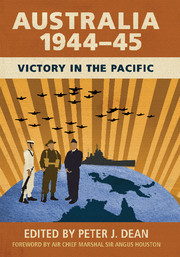Book contents
- Frontmatter
- Dedication
- Foreword
- Contents
- Maps and chart
- Figures and table
- Contributors
- Acknowledgements
- Abbreviations
- Military symbols on maps
- Introduction
- PART 1 STRATEGY
- PART 2 AUSTRALIA AT WAR
- PART 3 GREEN ARMOUR AND SPECIAL OPERATIONS
- PART 4 THE NAVAL AND AIR WAR
- PART 5 THE NEW GUINEA CAMPAIGN
- PART 6 THE BORNEO CAMPAIGN
- 12 Amphibious Warfare: Training and Logistics, 1942–45
- 13 ‘To capture Tarakan’: Was Operation Oboe 1 Unnecessary?
- 14 Unique in the history of the AIF’: Operations in British Borneo
- 15 ‘Calling the tune’: Australian and Allied Operations at Balikpapan
- Afterword: And Then Came Peace?
- Index
- References
15 - ‘Calling the tune’: Australian and Allied Operations at Balikpapan
from PART 6 - THE BORNEO CAMPAIGN
Published online by Cambridge University Press: 05 December 2015
- Frontmatter
- Dedication
- Foreword
- Contents
- Maps and chart
- Figures and table
- Contributors
- Acknowledgements
- Abbreviations
- Military symbols on maps
- Introduction
- PART 1 STRATEGY
- PART 2 AUSTRALIA AT WAR
- PART 3 GREEN ARMOUR AND SPECIAL OPERATIONS
- PART 4 THE NAVAL AND AIR WAR
- PART 5 THE NEW GUINEA CAMPAIGN
- PART 6 THE BORNEO CAMPAIGN
- 12 Amphibious Warfare: Training and Logistics, 1942–45
- 13 ‘To capture Tarakan’: Was Operation Oboe 1 Unnecessary?
- 14 Unique in the history of the AIF’: Operations in British Borneo
- 15 ‘Calling the tune’: Australian and Allied Operations at Balikpapan
- Afterword: And Then Came Peace?
- Index
- References
Summary
From 0715 on the morning of 1 July 1945, 126 LVT-4 ‘Alligators’, lumbered down the ramps of the landing ships that had carried them from the island of Morotai and splashed into the sea offshore of the southeastern Borneo town of Balikpapan. Bobbing in the swell, the Alligators manoeuvred into two lines abreast. At 0834, the drivers of the first line gunned their engines, and, gurgling and belching exhaust fumes, the Alligators accelerated towards the shore; the second line followed three minutes later. Each Alligator carried around 25 troops from the 2/10th, 2/12th and 2/27th Australian Infantry Battalions – the assault waves of operation Oboe 2, the last Allied amphibious landing of the Second World War, and the largest ever under Australian command. The scene unfolding that clear morning along the beaches and ridgelines ahead provided an awe-inspiring demonstration of the way the Australians intended to fight. Captain Tom Kimber of the 2/27th Battalion recalled:
As we approached the shore the warships stood off and bombarded the shore. Then the bombers came over and bombed the area and as we neared the landing … rocket ships which stood off … about 100 yards from the shore, and they fired these hundreds and hundreds of rockets … It was a magnificent display of fire power.
By the time of the landings, there were few Australian senior officers who considered the operation necessary, and thus the manner in which it was conducted reflected their desire to protect the force while still attaining its stated objectives. The Australians would dictate the terms under which they fought to both their US partners and their Japanese enemy. That they were largely able to do so was testament to the high standard of training and leadership to be found in the Army by this stage in the war, and the overwhelming materiel superiority available to it. 1 July 1945, however, was not the first time the war had come to the east Borneo coast. Setting the broader series of air, naval and land operations mounted against Balikpapan in their strategic context reveals a disjointed relationship between Allied strategy, operations, and tactics there.
- Type
- Chapter
- Information
- Australia 1944–45Victory in the Pacific, pp. 320 - 340Publisher: Cambridge University PressPrint publication year: 2015



